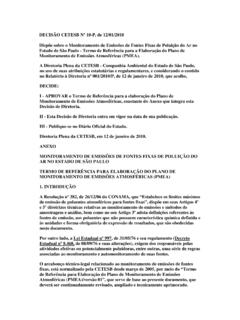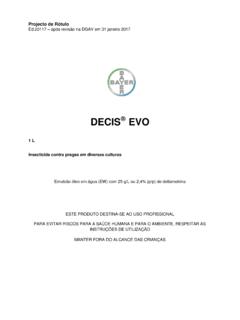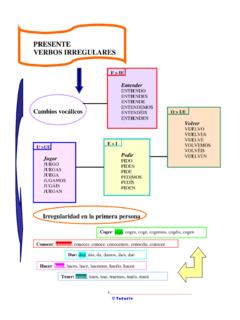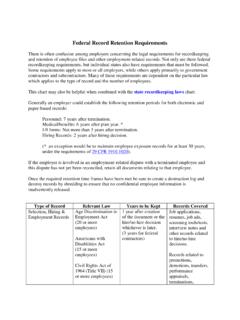Transcription of Two Stage Stochastic Linear Programming with GAMS
1 TWO Stage Stochastic Linear Programming with . GAMS. ERWIN KALVELAGEN. Abstract. This document shows how to model two- Stage Stochastic Linear Programming problems in a GAMS environment. We will demonstrate using a small example, how GAMS can be used to formulate and solve this model as a large LP or using specialized Stochastic solvers such as OSL-SE and DECIS. Finally a tailored implementation of the Benders Decomposition algorithm written in GAMS is used to solve the model. 1. Introduction Stochastic Programming has become an important problem area. with cur- rent standard off-the-shelf software including modeling systems such as AMPL and GAMS, powerful large-scale general-purpose solvers such as Cplex and specialized Stochastic Programming solvers such as OSL-SE and DECIS, end-users can develop realistic Stochastic Programming models and solve them on standard desktop hard- ware.
2 2. Two- Stage Stochastic Linear Programming problems The two- Stage Stochastic Linear Programming problem can be stated as [2, 5, 8]: SLP minimize cT x + E Q(x, ). x Ax = b x 0. where Q(x, ) = min dT y y (1) T x + W y = h . y 0. Here E is the expectation, and denotes a scenario or possible outcome with respect to the probability space ( , P ). The variables x are called first- Stage vari- ables, as they have to be decided upon before the outcome of the Stochastic variable is observed. The variables y are second- Stage variables: they can be calculated after the outcome of is known. We will consider discrete distributions P only, so we can write: X. (2) E Q(x, ) = p( )Q(x, ).. Date: 8 january 2003. 1. 2 ERWIN KALVELAGEN. Using this we can formulate a large LP that forms the deterministic equivalent problem: X. min cT x + p( )dT y .. (3) Ax = b T x + W y = h.
3 X 0, y 0. The chain of events in this model is as follows: first the decision maker im- plements the first Stage decisions x. Then the system will be subjected to the random process described by ( , P ), which results in an outcome . Finally the decision maker will execute the second Stage decisions y accordingly. 3. Example The standard transportation model can be stated as: X. TRANSPORT minimize ci,j xi,j x i,j X. xi,j = si i j X. xi,j = dj j i xi,j 0. where ci,j are the unit transportation costs, si is the supply at plant i and dj is the demand at location j. Now consider the case that demand dj is Stochastic . We assume that products are shipped before the actual demand is observed. After the products arrive at each location j, actual demand is known. If demand is not met, the sales is lost. If the shipment is larger than the final demand, then the remaining products need to be disposed of as they have no shelf life ( they spoil).
4 Unit disposal costs are known. To model this, first assume we somehow know the demand. This means we can build a non- Stochastic version of the model, also called the core model: X X X X. max pj Salesj ci,j Shipi,j ci Prodi cj Wastej j i,j i j X. Prodi = Shipi,j j (4) Prodi capi X. Shipi,j = Salesj + Wastej i Salesj demandj Salesj 0, Shipi,j 0, Prodi 0, Wastej 0. In this model we try to maximize profit, revenue minus costs, where costs can be broken down in production costs, transportation costs and waste disposal costs. 3. Outcome Probability j Lo Mid Hi Lo Mid Hi 1 150 160 170 .25 .50 .25. 2 100 120 135 .25 .50 .25. 3 250 270 300 .25 .50 .25. 4 300 325 350 .30 .40 .30. 5 600 700 800 .30 .40 .30. Table 1. Probability distribution of demand figures This model is just a little bit more complex than the transportation. When solved like this, it is expected the model will choose W astej = 0 as it does not contribute to the profit.
5 When we substitute this value in the model, the transportation model follows immediately. To quickly assess the correctness of the model one can solve a few instances of this model. We need to have some values for the demand. If only distributions are known some good candidates are setting demandj to the mean, the worst or best possible cases, or using some random drawings. When we make demandj Stochastic , the problem becomes more involved. First we need to define the probability distribution. Assume the data from table 1 are used. We assume the probabilities are independent. To calculate the joint probabilities for all demand markets, we note that P r(d1 = 150 d2 = 100 d3 = 250 d4 = 300 d5 = 600) =. (5)..25 .25 .25 .30 .30 = There are in total 35 = 243 scenario's. We are now able to formulate the deterministic equivalent of the Stochastic model: X X.
6 Max Profit = pj prob Salesj, ci,j Shipi,j j, i,j X X. ci Prodi cj prob Wastej, . i j, . X. Prod i = Shipi,j (6) j Prod i capi X. Shipi,j = Salesj, + Wastej, . i Salesj, demandj Salesj, 0, Shipi,j 0, Prodi 0, Wastej, 0. It is noted that the constraint X. (7) Shipi,j = Salesj, + Wastej, . i 4 ERWIN KALVELAGEN. P. is not very efficient as stated: the term i Shipi,j is repeated for all possible values of . In a case like this it is better to introduce a modest amount of extra inter- mediate variables and equations in order to achieve a significant reduction in the number of nonzero elements. We therefore would prefer the following formulation: X. Receivedj = Shipi,j (8) i Receivedj = Salesj, + Wastej, . A few remarks can be made. The second Stage is only how to deal with the products received: they are either sold (up to demandj ) or disposed of.
7 This is a particular easy decision: sell as much as you can, and destroy the rest. In more complicated situations, after an observation becomes available, we need either to solve a (smaller) second Stage LP model or in case we recorded all second Stage variables, we can select the correct solution values. It is noted that the second Stage problem is feasible for any . In this example we assumes the events for each demand market were independent. This may not be a valid assumption: if the market region j is down then it may be more likely that market region k is also likely to suffer. In case of perfect correlation, we would end up with a much smaller model as there would be only three scenario's: low, mid and high. The complete model formulated in GAMS is reproduced below. 1. Model $ontext Transportation problem with Stochastic demands. Erwin Kalvelagen, January 2003.
8 $offtext sets i 'factories' /f1*f3/. j 'distribution centers' /d1*d5/. s 'individual scenarios' /lo,mid,hi/. ;. parameter capacity(i) /f1 500, f2 450, f3 650/;. table demand(j,s) 'possible outcomes for demand'. lo mid hi d1 150 160 170. d2 100 120 135. d3 250 270 300. d4 300 325 350. d5 600 700 800. ;. table prob(j,s) 'probabilities for table demand'. lo mid hi d1 .25 .50 .25. d2 .25 .50 .25. d3 .25 .50 .25. d4 .30 .40 .30. d5 .30 .40 .30. ;. loop(j, abort$(abs(sum(s,prob(j,s))-1)> ) "probabilities don't add up");. 1 5. *. * set up joint probabilities * total scenarios = 3**5 = 243. *. set js 'scenarios for joint probabilities' /js1*js243/;. parameter jdemand(j,js) 'joint distribution: outcomes';. parameter jprob(js) 'joint distribution: probabilities';. alias (s,s1,s2,s3,s4,s5);. set current(js);. current('js1') = yes;. loop((s1,s2,s3,s4,s5), jdemand('d1',current) = demand('d1',s1).)
9 Jdemand('d2',current) = demand('d2',s2);. jdemand('d3',current) = demand('d3',s3);. jdemand('d4',current) = demand('d4',s4);. jdemand('d5',current) = demand('d5',s5);. jprob(current) = prob('d1',s1)*prob('d2',s2)*prob('d3',s3 )*prob('d4',s4)*prob('d5',s5);. current(js) = current(js-1);. );. display jdemand,jprob;. scalar sumprob;. sumprob = sum(js, jprob(js));. display sumprob;. abort$(abs(sumprob-1)> ) "joint probabilities don't add up";. table transcost(i,j) 'unit transportation cost'. d1 d2 d3 d4 d5. f1 f2 f3 ;. scalar prodcost 'unit production cost' /14/;. scalar price 'sales price' /24/;. scalar wastecost 'cost of removal of overstocked products' /4/;. *--------------------------------------- -------------------------------- * first we formulate a non- Stochastic version of the model * we just use 'mid' values for the demand. *--------------------------------------- -------------------------------- variables ship(i,j) 'shipments'.
10 Product(i) 'production'. sales(j) 'sales (actually sold)'. waste(j) 'overstocked products'. profit ;. positive variables ship,product,sales,waste;. equations obj production(i). selling(j). ;. profit =e= sum(j, price*sales(j)) - sum((i,j), transcost(i,j)*ship(i,j)). - sum(j, wastecost*waste(j)) - sum(i,prodcost*product(i));. production(i).. product(i) =e= sum(j, ship(i,j));. (i) = capacity(i);. selling(j).. sum(i, ship(i,j)) =e= sales(j)+waste(j);. (j) = demand(j,'mid');. 6 ERWIN KALVELAGEN. model Size m/n/nz Obj nonstoch 9/29/72 stoch 1224/2454/6132 Table 2. Results model nonstoch /obj,production,selling/;. solve nonstoch maximizing profit using lp;. display , , , ;. parameter shipnonstoch(i,j);. shipnonstoch(i,j) = (i,j);. *--------------------------------------- -------------------------------- * now we formulate a Stochastic version of the model * We form here the deterministic equivalent *--------------------------------------- -------------------------------- variables salesw(j,js) ' Stochastic version of sales'.









